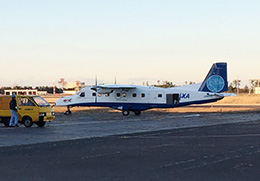Research & Development
JAXA promotes three research and development programs and a fundamental research program that underpins them.
Trajectory control technology
Flight experiments using MuPAL-α to enable precise curved approaches performed
From December 15 to 19, 2014, JAXA conducted flight experiments with MuPAL-α research aircraft at Sendai Airport to verify how GBAS*1 could enable precise curved approaches.
In addition to creating the need for shorter intervals between take-offs and landings, escalating airport traffic levels are also leading to increased turbulence around airports and exacerbating noise problems for local residents. Tailoring operations to weather conditions and mitigating the noise around airports will require technology that enables curved paths and other types of flexible approaches.

The MuPAL-α at Sendai Airport
For its recent experiments, JAXA teamed up with the Electronic Navigation Research Institute (ENRI) to send TAP*2 data containing curved and multiple approach segments from ENRI’s ground-based GBAS at Sendai Airport to the MuPAL-α. Based on the path information it received, MuPAL-α then used its fly-by-wire feature to make a straight-in approach and a curved approach via simulated autoflight system. The results of the experiment will aid in the verification of the automatic control system that the DREAMS Project has developed and help verify in-cockpit display devices. The success of the study owes a great deal to the wide-ranging support and cooperation of ENRI, the Tokyo Regional Civil Aviation Bureau, the Sendai Airport office, the Civil Aviation College, and other organizations.
*1:GBAS: Ground-Based Augmentation System; A system that uses satellite information to aid aircraft landing; the system uses computers to process positioning signals from multiple ground-based stations and then sends correction information, ground-based station location information, runway information, flight path information, GPS satellite information, and other data to aircraft via VHF to enable extremely high-accuracy guidance.
*2:TAP: Terminal Area Path; A data format currently being researched and developed as a GBAS extension; the technology makes it possible to send multiple- and curved approach segment to aircraft
March 31, 2015